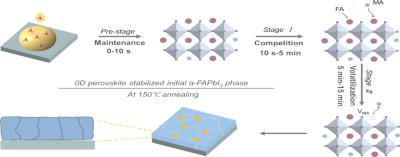While formamidinium lead triiodide (FAPbI3) perovskite can be used to create highly efficient perovskite solar cells (PSCs), the thermodynamically unstable α-phase poses a challenge to device long-term stability. Thermal annealing is essential for producing high-quality polycrystalline films that stabilize the α-FAPbI3 phase, but it also induces partial decomposition of FAPbI3 into PbI2, leading to extra phase instability of FAPbI3 films.
Researchers from the University of Science and Technology of China, Chinese Academy of Sciences, NingboTech University and Nankai University have developed a zero dimensional (0D) perovskite-decorated strategy to enhance the intrinsic stability of FAPbI3 film by stabilization of the initially formed α-FAPbI3 phase.
This is achieved by reducing the defect density and forming mixed 0D/3D perovskites, which effectively slow down perovskite decomposition during thermal annealing and decrease the amount of residual PbI2 in the final film.
The reduced trap density in 0D perovskite-treated PSCs suppresses Shockley-Read-Hall nonradiative recombination and improves charge collection efficiency. Consequently, the 0D perovskite-decorated PSCs endow significant enhancements in both power conversion efficiency (from 22.23% to 24.56%) and device stability.
This 0D perovskite-decorated strategy stabilized the initially formed α-FAPbI3 phase, offering an effective approach for both stabilizing FA-based perovskite film and managing PbI2 residues from perovskite decomposition, thereby paving the way to achieve efficient and stable PSCs.


